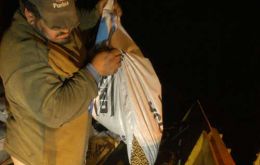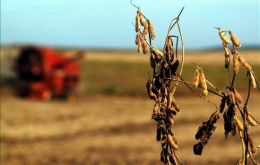MercoPress. South Atlantic News Agency
Tag: Uruguayan farmers
-
Friday, February 2nd 2018 - 08:18 UTC
Un-convened and unconvinced Uruguayan farmers again take to the roads

Un-convened and unconvinced Uruguayan farmers again took to the roads of the country for a peaceful protest vigil in an estimated 300 posts, and which counted with spontaneous support from small business people linked to the rural sector.
-
Wednesday, January 24th 2018 - 10:02 UTC
“Enough is enough”, thousands of Uruguayan farmers tell the government

“Enough is enough”, an end to the bloated state and its fiscal voracity, so that Uruguayan farmers can recover competitiveness, was the clear message from tens of thousands who gathered in central Uruguay to express their disenchantment with president Tabare Vazquez administration attitude towards the rural sector.
-
Tuesday, January 23rd 2018 - 07:10 UTC
A long announced summer surprise for the Uruguayan government of Vazquez and Mujica

Anywhere between 8.000 and 50.000 people are expected to convene on Tuesday to Durazno, central Uruguay, to protest and demand solutions to what is seen as an over bloated government, fiscal strangling, incompetent management of government companies and an overall dissatisfaction with the results of these policies and deaf political ears to the ongoing complaints.
-
Wednesday, January 17th 2018 - 08:37 UTC
Uruguayan farmers surprise government and take to the roads to protest fiscal policies

Uruguayan farmers with their tractors, harvesters, trucks, vans and on horseback took to the roads to protest the cost of fuel, power, increased taxes and an over bloated national budget and bureaucracy which they blame for making several farm activities unprofitable, and have had an overall negative impact for the different camp activities.
-
Tuesday, January 14th 2014 - 07:50 UTC
China becomes the leading market for Uruguayan meat exports

Uruguay's meat exports slid 6.5% in volume during 2013 compared to the previous year, but the big news is that China has become the main client for beef, followed by Nafta countries, (US, Canada and Mexico), according to the latest release from the country's National Meat Institute, INAC.
-
Monday, December 2nd 2013 - 18:38 UTC
Uruguay after another soy-crop record since area planted increased 100.000 hectares

Uruguay's soy beans coming crop will have increased 100.000 hectares, reaching between 1.3 and 1.35 million hectares, a new record according to the latest report from the National Seeds Institute, Inase. This compares with the 1.2 to 1.25 million hectares of the last crop.
-
Tuesday, November 22nd 2011 - 01:46 UTC
World Bank loan to help Uruguayan farmers address climate change consequences

The World Bank approved last week a loan for 49 million dollars to support Uruguayan farmers in adopting environmentally sustainable practices to improve the resilience of their production systems in response to the effects of climate variability.
